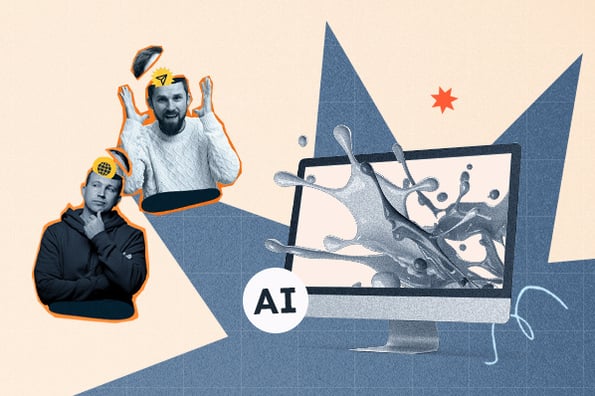For marketers, AI-generated imagery tools open up new possibilities for content personalization and campaign engagement…but only when applied in strategic, targeted ways.

AI-generated imagery platforms like Flux, Runway, and DALL-E are becoming a valuable part of marketing, design, and UX toolkits. But with all the options available, it’s sometimes difficult to understand where and how these tools actually bring value — and where they fall short.
![Download Now: The Annual State of Artificial Intelligence in 2024 [Free Report]](https://no-cache.hubspot.com/cta/default/53/b72f2b25-8cc9-4642-9a1b-1e675d3d273b.png)
In a recent Marketing Against the Grain episode, Kieran and I discuss common challenges teams face when using AI image tools, practical use cases for maximum performance, and best practices for integrating AI imagery into your workflow.
Three Key Challenges of AI-Generated Image Adoption
AI image generation holds massive potential — but its adoption isn’t without hurdles. In particular, three challenges preventing widespread use that Kieran and I often see are:
1. Hesitation due to privacy and security concerns.
Employees hesitate to engage with AI tools, often due to concerns around privacy, data security, and AI’s current limitations. Many also feel that AI might not yet be “good enough” for their needs.
Addressing these concerns starts with clear communication about AI’s strengths and limitations. When teams understand where AI can add value — and where it can’t — they’re more likely to engage with it in a realistic way.
2. Misaligned expectations.
Users often expect AI to “do it all,” leading to frustration when it falls short, especially for tasks requiring precision. As Kieran pointed out, employees sometimes treat AI as a “magic box,” which can set them up for disappointment.
By managing expectations and educating teams on how AI works best, marketers can shift focus toward the achievable, practical uses that make an impact.
3. A need for guardrails.
With such broad potential, many people struggle to find the right applications for AI. As Kieran highlighted during the show, a defined, structured approach — like having clear AI prompts or targeted use cases — helps ease adoption by giving employees a clearer sense of purpose.
Similarly, using guided prompts or simplified interfaces for specific tasks can make it easier for teams to explore AI without feeling overwhelmed.
Three AI-Generated Image Use Cases in Marketing
Despite these challenges, AI image tools can have a strong impact when applied to targeted use cases. In our experience, AI-generated imagery tools can be used to:
1. Boost ad performance.
In my opinion, one of the most effective applications of AI-generated imagery is creating tailored ad variations. Custom images that closely align with specific ad copy help marketers deliver a more personalized experience across different platforms.
In our tests at HubSpot, we’ve seen that this approach significantly boosts conversions, making it an invaluable tool for efficiently scaling our ad campaigns.
2. Increase email engagement.
AI can also increase engagement in email marketing by generating unique images tailored to each message.
Combined with AI-generated text, these visuals create a curated and relevant experience for readers, adding a layer of personalization that keeps content fresh and increases the chance of connecting with audiences in a deeper, more memorable way.
This approach works particularly well when you need to create distinct visuals for different segments or campaigns at scale.
3. Save time on editing.
AI is equally valuable for image editing, helping marketers quickly adjust visuals to fit different audience needs.
For example, a technology company might use AI to modify product screenshots by adding a client’s logo or emphasizing specific features.
This tactic allows brands to deliver a more personalized visual experience without the time and effort required for manual edits, making it a powerful option for scalable, audience-specific content.
Best Practices for AI Image Implementation
Maximizing the value of AI-generated images means knowing where and how to use them. These pointers will keep your approach practical and results-focused.
✔ Define clear use cases. Since AI can be overwhelming, define specific applications (like customer support or ad variations) where it’s most likely to succeed, rather than trying to apply it universally.
✔ Focus on volume over perfection. AI excels at creating multiple variations rather than single “perfect” images. If you need one flawless image, stick with traditional methods.
✔ Educate teams on AI’s strengths and limits. To improve adoption, set clear expectations and provide guidance on where AI is most beneficial, which can help address resistance due to privacy and reliability concerns.
✔ Keep it authentic. Avoid using AI-generated images to represent real people or customers, as this could damage trust. Save AI imagery for conceptual or product-focused visuals.
To learn more about how marketing leaders can integrate AI-generated imagery into their teams and workflows, check out the full episode of Marketing Against the Grain.
This blog series is in partnership with Marketing Against the Grain, the video podcast. It digs deeper into ideas shared by marketing leaders Kipp Bodnar (HubSpot’s CMO) and Kieran Flanagan (SVP, Marketing at HubSpot) as they unpack growth strategies and learn from standout founders and peers.








![Real or AI-Generated? You Guess [Quiz] real-or-ai-generated?-you-guess-[quiz]](https://blog.contentkrush.com/wp-content/uploads/2024/12/140633-real-or-ai-generated-you-guess-quiz-510x369.png)


![New Marketing Jobs That Focus on AI [Data + Examples] new-marketing-jobs-that-focus-on-ai-[data-+-examples]](https://blog.contentkrush.com/wp-content/uploads/2024/09/140151-new-marketing-jobs-that-focus-on-ai-data-examples-510x369.webp)


![What Jobs Will AI Replace & Which Are Safe in 2024 [+ Data] what-jobs-will-ai-replace-&-which-are-safe-in-2024-[+-data]](https://blog.contentkrush.com/wp-content/uploads/2024/08/140115-what-jobs-will-ai-replace-which-are-safe-in-2024-data-510x369.webp)


![How AI Will Impact Advertising, According to Top Marketing Executives [New Data] how-ai-will-impact-advertising,-according-to-top-marketing-executives-[new-data]](https://blog.contentkrush.com/wp-content/uploads/2025/04/141350-how-ai-will-impact-advertising-according-to-top-marketing-executives-new-data-510x369.jpg)












Comment here